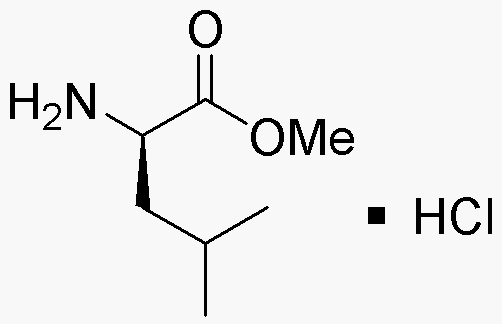D-Leucine methyl ester hydrochloride is widely utilized in research focused on:
- Peptide Synthesis: This compound serves as a valuable building block in the synthesis of peptides, which are essential in drug development and biochemistry.
- Pharmaceutical Formulations: It is used in the formulation of various pharmaceuticals, enhancing the solubility and bioavailability of active ingredients, making medications more effective.
- Protein Engineering: Researchers leverage this compound in protein engineering applications, aiding in the design of proteins with improved stability and functionality.
- Metabolic Studies: D-Leucine methyl ester hydrochloride is instrumental in metabolic studies, helping scientists understand amino acid metabolism and its implications for health and disease.
- Food Industry Applications: This chemical is also explored in the food industry for flavor enhancement and as a potential ingredient in nutritional supplements, providing a source of essential amino acids.
General Information
Properties
Safety and Regulations
Applications
D-Leucine methyl ester hydrochloride is widely utilized in research focused on:
- Peptide Synthesis: This compound serves as a valuable building block in the synthesis of peptides, which are essential in drug development and biochemistry.
- Pharmaceutical Formulations: It is used in the formulation of various pharmaceuticals, enhancing the solubility and bioavailability of active ingredients, making medications more effective.
- Protein Engineering: Researchers leverage this compound in protein engineering applications, aiding in the design of proteins with improved stability and functionality.
- Metabolic Studies: D-Leucine methyl ester hydrochloride is instrumental in metabolic studies, helping scientists understand amino acid metabolism and its implications for health and disease.
- Food Industry Applications: This chemical is also explored in the food industry for flavor enhancement and as a potential ingredient in nutritional supplements, providing a source of essential amino acids.
Documents
Safety Data Sheets (SDS)
The SDS provides comprehensive safety information on handling, storage, and disposal of the product.
Product Specification (PS)
The PS provides a comprehensive breakdown of the product’s properties, including chemical composition, physical state, purity, and storage requirements. It also details acceptable quality ranges and the product's intended applications.
Certificates of Analysis (COA)
Search for Certificates of Analysis (COA) by entering the products Lot Number. Lot and Batch Numbers can be found on a product’s label following the words ‘Lot’ or ‘Batch’.
*Catalog Number
*Lot Number
Certificates Of Origin (COO)
This COO confirms the country where the product was manufactured, and also details the materials and components used in it and whether it is derived from natural, synthetic, or other specific sources. This certificate may be required for customs, trade, and regulatory compliance.
*Catalog Number
*Lot Number
Safety Data Sheets (SDS)
The SDS provides comprehensive safety information on handling, storage, and disposal of the product.
DownloadProduct Specification (PS)
The PS provides a comprehensive breakdown of the product’s properties, including chemical composition, physical state, purity, and storage requirements. It also details acceptable quality ranges and the product's intended applications.
DownloadCertificates of Analysis (COA)
Search for Certificates of Analysis (COA) by entering the products Lot Number. Lot and Batch Numbers can be found on a product’s label following the words ‘Lot’ or ‘Batch’.
*Catalog Number
*Lot Number
Certificates Of Origin (COO)
This COO confirms the country where the product was manufactured, and also details the materials and components used in it and whether it is derived from natural, synthetic, or other specific sources. This certificate may be required for customs, trade, and regulatory compliance.


